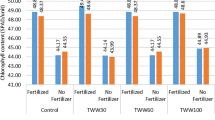Abstract
Relationships between radish thiocyanate content and its dry weight, the content of sugar, protein, fibre, ascorbic acid, some minerals, the incidence of plant shooting, the firmness and pithiness of storage-roots, and the ratio of leaves to storageroot (wt/wt) were investigated. The analysis of linear correlation was based on numerous data from the 4-year field experiment with six radish cultivars and different sowing and harvest dates. The content of thiocyanate in radish roots was found to be positively correlated with their dry weight, and the content of total protein, crude fibre, and soluble sugar. A strong relationship was found between the content of thiocyanate and dry weight of radish leaves. The negative correlation between the thiocyanate content in the leaves and the firmness of storageroots and the positive correlation with their pithiness might indicate the translocation of this compounds into green plant parts during the ageing of root tissue. The root thiocyanate content and the percentage of shooting correlated significantly only in the case of Tokinashi. The closeness of relations between the ratio of leaves/storage-root and thiocyanate content, though in general small, was affected also by a cultivar. A similar effect was observed for the correlations between the thiocyanate contents in leaves and storage-roots.
Similar content being viewed by others
References
Bible B., Chong C., 1975. Content of thiocyanate goiterogen in radishes as related to nutrient concentration and sulphur nutrition. J. Amer. Soc. Hort. Sci. 100(4): 428–431.
Capecka E., Libik A., 1993. Description of usable traits of Japanese radish Raphanus sativus L. ssp. raphanistroides (Makino) in field conditions. Folia Hort. V/2: 69–78.
Capecka E., Libik A., 1994. Wartość użytkowa rzodkwi letniej Rex i japońskiej Tokinashi w aspekcie ich przydatności do uprawy polowej. Biul. Warz. XLI: 17–27. (in Polish)
Capecka E., 1996. Changes in the contents of some organic compounds during hypocotyl-root growth of radish Raphanus sativus L. cultivars. Folia Hort. 8/2: 121–129.
Capecka E., 1998. Changes in thiocyanate content in some radish Raphanus sativus L cultivars during hypocotyl-root growth. Acta Physiol. Plant. 20: 135–142.
Carlson D. G., Daxenbichler M.E., VanEtten C.H., Hill C. B., Williams P. H., 1985. Glucosinolates in radish cultivars. J. Amer. Soc. Hort. Sci. 110(5): 634–638.
Chong C., Bible B., 1974 a. Relationship between top/root ratio and thiocyanate content in roots of radishes and turnips. HortScience. 9(3): 230–231.
Chong C., Bible B., 1974 b. Variation in thiocyanate content of radish plants during ontogeny. J. Amer. Soc. Hort. Sci. 99(2): 159–162.
Chong C., Kanakis A. G., Bible B. B., 1982. Influence of growth regulators on ionic thiocyanate content of cruciferous vegetable crops. J. Amer. Soc. Hort. Sci. 107(4): 586–589.
Fenwick G. R., Heaney R. K., Mullin W. J., 1983. Glucosinolates and their breakdown products in food and food plants. CRC Critical Reviews in Food Science and Nutrition. 18(2): 123–201.
Gawęda M., Kopecka Z., Capecka E., 1991 a. Effect of some environmental conditions on quality of the radish Raphanus sativus L. I. Biological value. Folia Hort. III/1: 47–59.
Gawęda M., Kopecka Z., Capecka E., 1991 b. Wpływ terminów siewu na plonowanie odmian rzodkwi (Raphanus sativus L. subvar. niger Pers.). Materiały z Ogólnopolskiego Zjazdu Hodowców Roślin Warzywnych. A.R. Kraków: 119–123. (in Polish)
Ishii G., Saijo R., Mizutani J., 1989a. A quantitive determination of 4-methylthio-3-butenyl glucosinolate in daikon (Raphanus sativus L.) roots by gas liquid chromatography. J. Japan. Soc. Hort. Sci. 58(2): 339–344.
Ishii G., Saijo R., Nagata M., 1989b. The difference of glucosinolate content in different cultivars of daikon roots (Raphanus sativus L.). Nippon Shokuhin Kogyo Gakkaishi. 36(9): 739–742.
Ju H.-Y., Chong C., Mullin W.J., Bible B. B., 1982. Volatile isothiocyanates and nitriles from glucosinolates in rutabaga and turnip. J. Amer. Soc. Hort. Sci. 107(6): 1050–1054.
Kim Y. S., Kim Y. C., Park K. W., 1983. Influence of irrigation and cultivar on thiocyanate ion content in radish and Chinese cabbage. J. Kor. Soc. Hort. Sci. 24(1): 9–13.
Lutomski J., Speichert H., 1982. Schwarzrettich als Quelle einiger Phytopharmaka. Pharm. in u. Zeit. 11(5): 151–155.
Okano K., Asano J., Ishii G., 1990. Contents of pungent principle in roots of Japanese radish (Raphanus sativus L.) cultivars. J. Japan. Soc. Hort. Sci. 59(3): 551–558.
Olsen O., Sorensen H., 1981. Recent advances in the analysis of glucosinolates. J. Amer. Oil Chem. Soc. 58(9): 857–865.
Ozawa Y., Uda Y., Ohishima T., Saito K., Maeda Y., 1990. Formation of yellow pigment by reaction of 4-methylthio-3-butenyl isothiocyanate with L-ascorbic acid and some dihydroxyphenolic compounds. Agric. Biol. Chem. 54(3): 605–611.
Park K. W., Kim M. Z., 1985. Studies on the quality of radish. II. Differences of some quality components between cultivars and parts of the root. J. Kor. Soc. Hort. Sci. 26(3): 226–230.
Rumińska A., 1990. Rzodkiew czarna. in: Leksykon Roślin Leczniczych. PWRiL. Warszawa: 449. (in Polish)
Author information
Authors and Affiliations
Rights and permissions
About this article
Cite this article
Capecka, E. Thiocyanate content in relation to the quality features of radish Raphanus sativus L. Acta Physiol Plant 20, 143–147 (1998). https://doi.org/10.1007/s11738-998-0005-5
Received:
Accepted:
Published:
Issue Date:
DOI: https://doi.org/10.1007/s11738-998-0005-5




